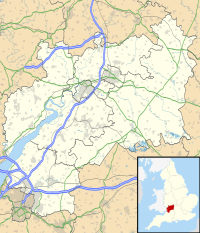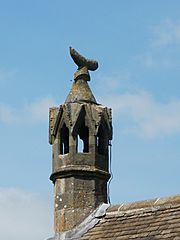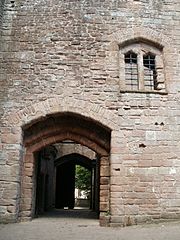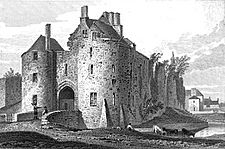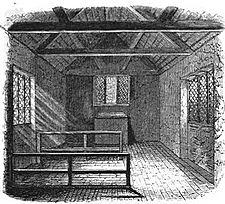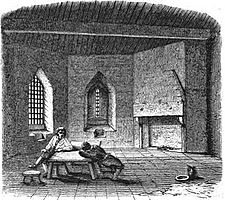St Briavels Castle facts for kids
Quick facts for kids St Briavels Castle |
|
|---|---|
| Gloucestershire, England | |
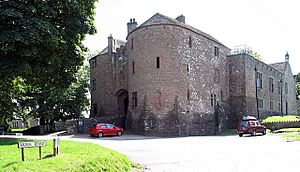
St Briavels Castle.
|
|
| Coordinates | 51°44′17″N 2°38′26″W / 51.7380°N 2.6405°W |
| Type | Bailey |
| Site information | |
| Owner | English Heritage |
| Controlled by | English Heritage |
| Condition | Inhabited and used as a Youth Hostel |
| Site history | |
| Materials | Old Red Sandstone and Limestone |
St Briavels Castle is an old Norman castle in St Briavels, Gloucestershire, England. It has a moat (a ditch filled with water) and is famous for its huge gatehouse built during the time of King Edward I.
The castle was first built between 1075 and 1129. It served as a royal office for the Forest of Dean, a large ancient woodland. In the 1200s, it became a favorite hunting spot for King John. Later, it was the main place in England where "quarrels" (special arrows for crossbows) were made for medieval wars. Over the years, the castle was given to different royal friends and slowly became less important.
St Briavels Castle was then used as a court and a prison for people who couldn't pay their debts. A prison reformer named John Howard wrote about the poor conditions there in 1775. After local protests and a government review in the 1830s, the castle stopped being a prison in the 1800s.
Around 1900, the castle was greatly repaired. In 1948, it became a Youth Hostel, which it still is today. English Heritage owns and manages the castle, and it is open for visitors. It is considered a very important historical building.
Contents
What Does St Briavels Castle Look Like?
St Briavels Castle sits on a hill overlooking the River Wye, near the edge of the Forest of Dean. It is mostly built from local red sandstone and limestone. A moat, now a garden, used to surround the castle. This moat was once filled with water from a natural spring.
The Castle's Main Tower: The Keep
The castle once had a square Norman tower called a keep. It was about 20 meters (66 feet) tall. This keep was built on a small hill of clay and stone, known as a motte. Sadly, the keep fell down and was removed in the 1700s. It probably looked like the keeps at Goodrich Castle and White Castle, which are similar castles nearby.
Protecting the Castle: Walls and Buildings
The keep was protected by strong stone walls, called a curtain wall, which you can still see today. These walls form the castle's main yard, or bailey. There was once a small round tower in the southeast corner and likely a gate in the south wall. Other buildings, like a forge (where metal was worked) and other structures, used to be along the northeast side of the bailey.
Some medieval buildings still stand along the northwest side of the bailey. These include a hall, a solar (a private room), and a chapel. These buildings were where the castle's leader and the King would stay. They were fixed up in the 1800s. Some parts, like the hall's fireplace, are from the 1200s. The hall and solar form a two-story building. The chapel, built in the 1300s, has changes from the 1600s.
One special feature is the "Forester's Horn" chimney. It has a horn on top, which was a symbol of the forest laws and the castle's power. The buildings also include a small prison pit. Old writings from 1671 show it was still used then.
The Grand Entrance: The Gatehouse
The gatehouse of St Briavels Castle is very impressive. It has two large D-shaped towers on either side of a wide entrance passage. This passage is about 14.8 meters (48 feet) long. A large room connects the towers above the passage. This type of gatehouse is sometimes called a "keep-gatehouse" because it is so big and well-defended.
What makes this gatehouse special is that it has three sets of portcullises (heavy grilles that drop down to block the entrance). Most gatehouses only had two. There are even smaller portcullises to protect the doorways leading from the passage to the guard rooms. The gatehouse used to be taller, and the entrance had a drawbridge, which was removed in the 1900s.
The bottom of the gatehouse has large "spurs" (stone extensions) to stop enemies from digging under it. This design is common in castles near the Welsh border. The gatehouse is very strong, except for the upper windows at the back. These windows were for important guests and let light into their rooms. The southeast part of the gatehouse is newer, rebuilt after it collapsed in the past.
A Look at St Briavels Castle's Past
Early Days: 1000s and 1100s
St Briavels Castle began in Norman times. The area was taken by William FitzOsbern in 1067. He built many castles nearby. However, it seems he did not build one at St Briavels. The village became part of the royal lands of the Forest of Dean.
The castle was built between 1075 and 1129 by order of the king. Walter de Gloucester and his son Miles de Gloucester made St Briavels Castle the main office for the Forest of Dean. The castle was far from the Welsh border, so it was likely built to help the king rule, not just to defend. Other castles like Restormel Castle and Lydford Castle served similar purposes. Some think it also protected the Severn estuary to the south. This early castle was a "motte and bailey" design, with a wooden tower.
Miles de Gloucester became very powerful. During a civil war in England (called the Anarchy), Miles supported Empress Matilda and took control of the castle. After the war, King Henry II took the castle back for the crown. Henry II rebuilt the castle's wooden keep with stone in the 1160s.
Royal forests in those days had special, strict laws. They provided hunting grounds, wood, and money for the king. The Forest of Dean was important for metalworking because it had many trees for charcoal and iron in the ground. Iron goods made locally were stored at the castle before being sent to other royal places. A lot of metal was produced. For example, in 1172, King Henry II received 100 axes, 1,000 picks, 2,000 shovels, and 60,000 nails from St Briavels Castle. King Richard I took 50,000 horseshoes from St Briavels for his crusade. The castle's leader was in charge of the forest, including managing the iron-workers through special courts at the castle.
The 1200s: A Center for Weapons

King John often visited the Forest of Dean for hunting and used St Briavels Castle as his base. He spent a lot of money (about £291) on building work there. Between 1209 and 1211, a stone curtain wall with a tower and gate replaced an older wooden one. Buildings for the king to stay in were also built inside the castle yard. By the end of King John's rule, the castle was almost fully developed.
In 1217, the Charter of the Forest was created to make forest laws less harsh. However, courts at St Briavels Castle still gave out many fines for cutting wood illegally or hunting deer without permission. The castle also started to be used as a prison for people who broke forest laws or couldn't pay their fines.
After King John died, St Briavels Castle became the main place in England for making "quarrels" (crossbow bolts). The crossbow was a very important weapon. Crossbows were mostly built at the Tower of London, but St Briavels Castle, with its local wood, became the national center for making the arrows.
In 1228, skilled workers like John Malemort started making quarrels at a forge inside the castle. By 1233, they could make 120,000 quarrels in 120 days. Workers like Malemort could make up to 100 quarrels a day! The quarrels were packed into barrels and sent across the kingdom. Other iron from the castle was used to build siege engines in Hereford. The castle's ability to make weapons gave the king a big advantage over his enemies.
Because it was a weapons center, the castle was made even stronger with a new ditch, repaired walls, and a new chapel. It was guarded by royal soldiers in 1233–34, showing its military importance. By 1287, the castle's leader was paid £20 a year, which was as much as the leaders of much larger castles like Rhuddlan or Nottingham.
Under King Edward I, the huge gatehouse was built to protect the castle entrance. It had special defenses against enemies trying to dig underneath. This work cost £477 between 1292 and 1293. It's not clear why the king built such a strong gatehouse, as the castle was far from the Welsh border and not in danger. One idea is that it was to protect the large amounts of weapons and money stored there. The extra portcullises support this idea. In 1300, the old wooden chapel was rebuilt in stone. In 1310, an extension called 'the Peel' was added to the castle wall for more protection.
From the 1300s to the 1600s

St Briavels Castle remained important during the rule of King Edward II. The Welsh border areas were key in the wars between the king and his nobles. Roger d'Amory was the castle's leader early in Edward's reign. King Edward II visited the castle several times, and about £500 was spent on fixing up the rooms.
D'Amory later fought against the king. After the war, Edward gave control of the Welsh border castles, including St Briavels, to the Despensers, a powerful family. The Despensers were very strict, and people in the area started to protest. In 1325, one of their officials was attacked on his way from St Briavels Castle. Edward and the Despensers were later removed from power by Edward's wife, Isabella of France. Isabella took St Briavels Castle for herself. When her son, Edward III, took over in 1330, the castle returned to the crown.
In the late 1300s, England had more conflicts between the Yorkist and Lancastrian families. St Briavels Castle was passed between important nobles from both sides, but it wasn't a major battle site. It was given to Thomas, Duke of Gloucester, then to Thomas le Despenser, then to the Duke of Bedford. Later, Henry Beauchamp and William Herbert owned it. After Herbert was executed, Richard Neville, Earl of Warwick, took the castle. After Warwick's death, King Henry VII gave it to Neville's widow, Anne Neville, 16th Countess of Warwick.
By this time, St Briavels Castle had been slowly falling apart for many years. Some small improvements were made, like new windows in the 1400s and changes to the chapel in the 1600s. But it wasn't made into a fancy home like some other castles.
Under King James I and King Charles I, the castle was usually given to the Earls of Pembroke. During the English Civil War, the castle was held by Philip Herbert, who sided with Parliament. So, St Briavels wasn't involved in the fighting. After the king returned to power in 1660, the castle was given to Henry, Lord Herbert of Raglan, and then to the Duke of Beaufort. After that, the castle was owned by less famous people.
The 1700s and 1800s: A Prison and Reforms
In the 1700s, many buildings inside the castle yard were torn down. Valuable materials, like lead from the roof, were reused. The keep (the main tower) partly collapsed in 1752, and the rest fell in 1777. People at the time blamed both age and locals taking stones. The famous "forester's horn" chimney was moved between 1783 and 1824. Even though it was a ruin, visitors in the 1700s still found the surrounding area "beautiful and romantic."
The castle was mainly used as a prison and court, still following the old Forest Law from 1217. The remaining buildings were turned into a courtroom and jury room. The west side of the gatehouse became a jail for prisoners. St Briavels Castle was mostly a debtors' prison. In England, until 1869, people who couldn't pay their debts could be kept in prison indefinitely.
The prison conditions became well-known after John Howard visited in 1775. He was researching for his book The State of the Prisons. Howard found the prison "greatly out of repair." Two prisoners were locked in one room for almost a year without exercise, fresh water, or firewood. Sad messages from prisoners, like "For I have been here a great space; And I am weary of the place," can still be seen on the jail walls.
In 1831, there were big protests in the Forest of Dean, led by Warren James. After the army stepped in, order was restored. But many complaints were made about the unfair laws for miners and metal-workers. There had been attacks on St Briavels Castle before, but these protests were much more violent. A new law was passed, and officials investigated what happened at the castle.
The debtors' prison at the castle was closely examined. It was found that most cases (397 out of 402) were for very small debts of £5 or less. This was seen as very unfair. A fee of up to £7 was also charged for each case, making it very hard for poor people. The investigation found that the prison keeper charged each prisoner one shilling a week for beds. Prisoners relied on friends, family, or donations for food and other needs.
The castle prison was still in very bad shape. The investigators noted it had "only one window, which is one foot wide and in a recess. It does not open.... There is no water within for the prisoners' liberty, and they are obliged to get some person to fetch it."
Changes were made to improve the prison. However, visitors still said the castle looked "patched and cobbled like a worn-out shoe." In 1838, the role of the castle's leader changed. The court and jury rooms became a local school. The castle stayed a prison until 1842, when the remaining prisoners were moved to a prison in Littledean.
St Briavels Castle Today
The gatehouse and other buildings inside the castle yard were made livable again in 1906. In 1948, the castle became a Youth Hostel. In 1961, part of the moat was filled in and turned into a garden.
Today, St Briavels Castle is a Grade I listed building and a Scheduled Monument. This means it is a very important historical site. The castle is open to the public and is managed by English Heritage.
Images for kids
-
The Edwardian castle gatehouse.
-
The octagonal "spurs" designed to prevent undermining.


